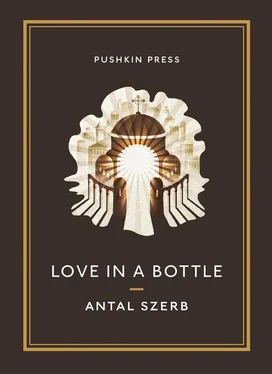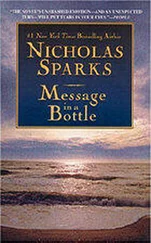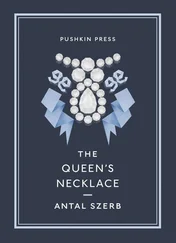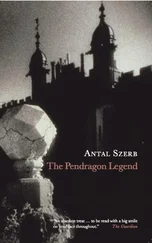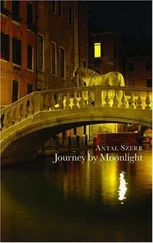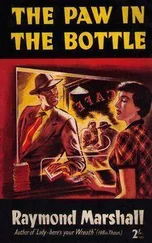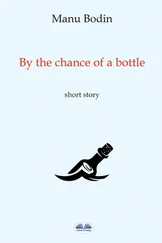Antal Szerb - Love in a Bottle
Здесь есть возможность читать онлайн «Antal Szerb - Love in a Bottle» весь текст электронной книги совершенно бесплатно (целиком полную версию без сокращений). В некоторых случаях можно слушать аудио, скачать через торрент в формате fb2 и присутствует краткое содержание. Год выпуска: 2013, Издательство: Pushkin Press, Жанр: Классическая проза, на английском языке. Описание произведения, (предисловие) а так же отзывы посетителей доступны на портале библиотеки ЛибКат.
- Название:Love in a Bottle
- Автор:
- Издательство:Pushkin Press
- Жанр:
- Год:2013
- ISBN:нет данных
- Рейтинг книги:5 / 5. Голосов: 1
-
Избранное:Добавить в избранное
- Отзывы:
-
Ваша оценка:
- 100
- 1
- 2
- 3
- 4
- 5
Love in a Bottle: краткое содержание, описание и аннотация
Предлагаем к чтению аннотацию, описание, краткое содержание или предисловие (зависит от того, что написал сам автор книги «Love in a Bottle»). Если вы не нашли необходимую информацию о книге — напишите в комментариях, мы постараемся отыскать её.
and
.
Love in a Bottle — читать онлайн бесплатно полную книгу (весь текст) целиком
Ниже представлен текст книги, разбитый по страницам. Система сохранения места последней прочитанной страницы, позволяет с удобством читать онлайн бесплатно книгу «Love in a Bottle», без необходимости каждый раз заново искать на чём Вы остановились. Поставьте закладку, и сможете в любой момент перейти на страницу, на которой закончили чтение.
Интервал:
Закладка:
“Splendid. And are you happy?”
“Happy? I’m only now starting to feel really myself. I used to be a slave. The last dirty slave. These days I live like the Good Lord himself. In France.”
“I’m so glad, Tom, really glad. Because I’ve been wanting to say to you for some time that you should relax and join in with things a bit more. But what I don’t understand is why you look so unwell. Your face is rather pale and careworn. Why is that?”
“I’ve no idea. Perhaps all the walking—”
“It’s as if you’re not really satisfied, Tom. Look, I know your face. There’s something missing in your life.”
“No, no. You’re quite wrong about that. I’ve never felt so well. I feel like a god!” he shouted angrily.
Jeannie was so astonished she made no reply.
They took coffee in the sitting room. Then Tom went through to the family library to stretch out and do some reading. There he found his fifteen-year-old nephew Fred sitting at the desk, scratching his head.
“Hello, Freddie. Why such a miserable face? Is something wrong?”
“Wrong? It’s this pesky homework! I’ve got this essay to write for tomorrow, about Shakespeare and Milton. I’m supposed to ‘compare and contrast’ them. Isn’t that crazy? Why were these two blighters ever born? And it’s Bournemouth v Aston Villa this afternoon.”
“Shakespeare and Milton? Hmm. You know what, my lad? You go off to the match, and I’ll write your essay. It’d be a shame to waste such a fine Sunday afternoon. Shakespeare and Milton. What a joke!”
“Would you really, Uncle Tom? I always said you were a thoroughly decent chap, Dad can say what he likes…”
And out he dashed.
Two hours later Jeannie came into the library. She found Tom working away feverishly, surrounded by densely scribbled sheets of paper, with a Shakespeare on the floor and Milton and the other classics scattered everywhere. The moment she entered Tom glanced up at the ceiling to show his irritation. He clearly didn’t take kindly to being interrupted.
“What are you doing, Tom?”
“Oh, er… I’m helping Freddie with his homework. ‘Compare Shakespeare and Milton’, I ask you! At first glance, you’d never think what a good subject it is. I’ve written fifteen sides and still hardly touched on the matter. I think the teacher will be pleased.”
A few days later Tom Maclean called on Peter Rarely. He found the millionaire in his music room, working on an experiment to get thirty parrots to speak in chorus. He nodded briefly as Tom entered. The parrots, who were in the middle of “God Save the King”, fell silent.
“Sir,” Maclean began, very formally and clearly embarrassed. “I am compelled to renege on our agreement. I must ask you not to remit the usual sum next month. I’m terribly sorry. I know it’s not exactly playing the game, but I really have no choice in the matter.”
“What? You want to start writing again?”
“Again? Now I want to start in earnest. So far I’ve just been lazing around. I’ve got the outlines of a five-volume novel sequence, an autobiography of indeterminate length and a life of James IV of Scotland. It’s time I really got going on them.”
“But haven’t you been happy without your writing?”
“No, sir. It’s just no good. If you threw me in prison I’d write in blood on my underwear, like that Mr Kazinczy my Hungarian friend told me about. I wish you good day.”
1937
THE DUKE
An Imaginary Portrait
ANYONE WHOSE WANDERINGS around Italy have led him to the little town of Cortemiglia, in the Alban hills near Rome, will have been sure to look over the palazzo, the one feature of note in the place apart from the famous paintings in the cathedral, that so greatly resemble those to be seen in the cathedrals of every other little Italian city. Indeed the Palazzo Sant’Agnese itself is hardly different from the thousands of other fine Renaissance and Baroque examples across the land. But if you do ever find yourself there, take a closer look, and you will be struck by the mellow, formally correct beauty of the place, and the magical sense of the past that lingers broodingly over it.
Indeed the building has now arrived at precisely the state most appropriate for such musings — for the past, for history itself, to reach out to you as a living reality. Here there is no glittering spectacle such as you find at Assisi, cleaned and tidied up for the tourist; nor is it so stark in its abandonment as to convey a feeling of oppression, of exhaling the miasma of the ruin of centuries. Virginia creeper clambers the walls at will, with a sort of spontaneous Italian artistry. Grass grows unobtrusively between the paving slabs in the grand courtyard, but nowhere runs to wild profusion. The palazzo is maintained and open to the public, though it takes a full half-hour, with the help of the ever-obliging and undemanding local street urchins, to rouse the custodian from wherever he might be and procure his services.
Once the outside of the building has been properly admired, the interior does not disappoint. Everything inside the rooms is of the finest materials, crafted in the most aristocratic taste — that is to say, nothing produced in our time comes anywhere near it. From the windows of the upper floors a serene, dream-like view opens out towards the haze of blue sunlight on the distant Tyrrhenian Sea. On one of the windows some poetical Englishman, or perhaps Englishwoman, has used a diamond ring to engrave Keats’s well-known line— A thing of beauty is a joy for ever.
And like the refrain of a poem, two motifs confront you at every turn. The first is the family coat of arms, depicting two swords and an ostrich feather. The second is the face of the man who commissioned it, Marcantonio Sant’Agnese. The Duke’s portrait, with its prominent nose and meaty cheeks, and their suggestion of opulence, not to say ostentation, is by Rusticaia. The full-length painting, in which he poses before a half-drawn purple-brown curtain, is by Marzio Filiboni. Behind the curtain can be glimpsed a wide, blue-green Renaissance landscape, with rivers and lakes, and tiny, toy-sized mountains. With his brow wreathed in laurel and a purple cloak draped over his ceremonial armour, the Duke stands foursquare. He is magnificently obese. His obesity is even more striking in the equestrian statue, by Mastagli, that stands in pride of place on the main terrace in the ancient park. Next to it is a fountain, on whose rim sits a nymph holding a little elephant in her hand. The water tumbles out though the elephant’s trunk onto an assortment of tritons, who struggle to hold their spiral conches up beneath its downpour — or rather, would struggle, if the water were ever to flow from the spring again. The fountain is later than the statue, executed in the manner of Bernini in the middle of the seventeenth century. Naturally neither the full-length portrait nor the statue gives any clue to the Duke’s psychology, but seeing the portrait one can imagine that behind those two tiny and not very benevolent-looking eyes, between the self-confident and grandiose meatiness of the corpulent cheeks, lurks a strange sense of panic. And the viewer might perhaps wonder what sort of person Marcantonio Sant’Agnese could have been in real life — in his long-ago life, in that long-vanished time.
The origin of the Sant’Agnese family was derived by Renaissance scholars from Agnosos, one of the heroes of The Odyssey , who is known only from a synopsis of the great cyclical epic. It records that this Agnosos was rescued from the waves by Pallas Athene’s owl when the Four Winds were misguidedly let out of their bag and promptly capsized the Greek ships. By happy chance the bird brought him to Italy, where he founded the family line with the help of a mountain nymph. More reliable chronicles assert that the original forebear was a Lombard hero called Balmungo, who took an active part in the assassination of King Alboïn and was rewarded with extensive domains in the vicinity of Benevent. Other accounts propose descent from St Agnes herself, but considering the saint’s well-known virginity this argument runs into certain difficulties. Whatever the truth might be, the fact is that at no time in the sixteenth century did the family play a role of any significance in Italian history, until one of its scions, as Callixtus VII, attained the throne of St Peter. Thereafter his brothers and cousins became bishops, papal generals, treasurers, gonfalonieri (governors of the more distant Christian lands) and lords of various lesser dukedoms. The Pope’s one grievance was that in all his long and illustrious reign he never managed to acquire an independent little principality for his own family. Nonetheless the Sant’Agnese wealth grew in this period to such legendary proportions that it rivalled those other nepotistical dynasties the Borghese, the Barberini and the Pamfili.
Читать дальшеИнтервал:
Закладка:
Похожие книги на «Love in a Bottle»
Представляем Вашему вниманию похожие книги на «Love in a Bottle» списком для выбора. Мы отобрали схожую по названию и смыслу литературу в надежде предоставить читателям больше вариантов отыскать новые, интересные, ещё непрочитанные произведения.
Обсуждение, отзывы о книге «Love in a Bottle» и просто собственные мнения читателей. Оставьте ваши комментарии, напишите, что Вы думаете о произведении, его смысле или главных героях. Укажите что конкретно понравилось, а что нет, и почему Вы так считаете.
